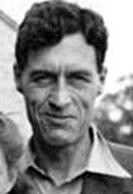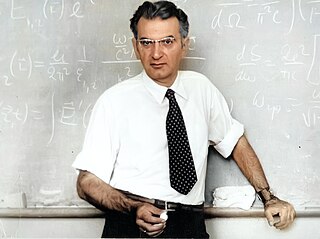Related Research Articles

Cosmic rays or astroparticles are high-energy particles or clusters of particles that move through space at nearly the speed of light. They originate from the Sun, from outside of the Solar System in our own galaxy, and from distant galaxies. Upon impact with Earth's atmosphere, cosmic rays produce showers of secondary particles, some of which reach the surface, although the bulk are deflected off into space by the magnetosphere or the heliosphere.

Edwin Mattison McMillan was an American physicist credited with being the first to produce a transuranium element, neptunium. For this, he shared the 1951 Nobel Prize in Chemistry with Glenn Seaborg.

Patrick Maynard Stuart Blackett, Baron Blackett,, was a British experimental physicist known for his work on cloud chambers, cosmic rays, and paleomagnetism, awarded the Nobel Prize in Physics in 1948. In 1925 he became the first person to prove that radioactivity could cause the nuclear transmutation of one chemical element to another. He also made a major contribution in World War II advising on military strategy and developing operational research. His views saw an outlet in third world development and in influencing policy in the Labour government of the 1960s.

Emilio Gino Segrè was an Italian and naturalized-American physicist and Nobel laureate, who discovered the elements technetium and astatine, and the antiproton, a subatomic antiparticle, for which he was awarded the Nobel Prize in Physics in 1959 along with Owen Chamberlain.

Bruno Benedetto Rossi was an Italian experimental physicist. He made major contributions to particle physics and the study of cosmic rays. A 1927 graduate of the University of Bologna, he became interested in cosmic rays. To study them, he invented an improved electronic coincidence circuit, and travelled to Eritrea to conduct experiments that showed that cosmic ray intensity from the West was significantly larger than that from the East.

Robert Frederick Christy was a Canadian-American theoretical physicist and later astrophysicist who was one of the last surviving people to have worked on the Manhattan Project during World War II. He briefly served as acting president of California Institute of Technology (Caltech).

Homi Jehangir Bhabha, FNI, FASc, FRS, Hon.FRSE was an Indian nuclear physicist who is widely credited as the "father of the Indian nuclear programme". He was the founding director and professor of physics at the Tata Institute of Fundamental Research (TIFR), as well as the founding director of the Atomic Energy Establishment, Trombay (AEET) which was renamed the Bhabha Atomic Research Centre in his honour. TIFR and AEET served as the cornerstone of the Indian nuclear energy and weapons programme. He was the first chairman of the Indian Atomic Energy Commission and secretary of the Department of Atomic Energy. By supporting space science projects which initially derived their funding from the AEC, he played an important role in the birth of the Indian space programme.

Mambillikalathil Govind Kumar Menon also known as M. G. K. Menon, was a physicist and policy maker from India. He had a prominent role in the development of science and technology in India over four decades. One of his most important contributions was nurturing the Tata Institute of Fundamental Research, Mumbai, which his mentor Homi J. Bhabha founded in 1945.

Piara Singh Gill was an Indian nuclear physicist and a pioneer in cosmic ray nuclear physics. He was the first Director of Central Scientific Instruments Organisation (CSIO) of India. He was research fellow of University of Chicago (1940). He was research Professorship fellow of Tata Institute of Fundamental Research (TIFR) (1947), Officer-on-Special Duty (OSD) with the Atomic Energy Commission in New Delhi. Professor and head of the Department of Physics at Aligarh University (1949), Director of Central Scientific Instruments Organization (CSIO) (1959) and Professor Emeritus at Punjab Agricultural University (1971).

Artem Alikhanian was a Soviet and Armenian physicist, one of the founders and first director of the Yerevan Physics Institute, a correspondent member of the Academy of Sciences of the Soviet Union (1946), academic of the Armenian National Academy of Sciences. With Pyotr Kapitsa, Lev Landau, Igor Kurchatov, Abram Alikhanov and others, he laid the foundations of nuclear physics in the Soviet Union. He is known as the "father of Armenian physics".

Gregory Markari (Markarovich) Garibian was a Soviet Armenian physicist, academician-secretary of the Department of Physics and Mathematics of the Armenian Academy of Sciences (AS)(1973–1991). He is known for developing the Theory of Transition Radiation and showing the feasibility of functional transition radiation detectors (TRDs). [8] [9]
Phyllis S. Freier was an American astrophysicist and a Fellow, American Association for the Advancement of Science and a Fellow, American Physical Society. Freier also served on NASA committees. As a graduate student she presented evidence for the existence of elements heavier than helium in cosmic radiation. Her work was published in Physical Review in 1948 with co-authors Edward J. Lofgren, Edward P. Ney, and Frank Oppenheimer.
Ranjan Roy Daniel was an Indian Nagercoil born physicist who worked in the fields of cosmic rays and space physics, and remained Director Chairman of Tata Institute of Fundamental Research. He also served as an advisor to the prime minister of India, Indira Gandhi in 1976. He worked in the field of cosmic rays with Homi Jehangir Bhabha for 23 years.
Lajos Jánossy was a Hungarian physicist, astrophysicist and mathematician and a member of the Hungarian Academy of Sciences. His primary research fields were astrophysics, nuclear physics, quantum mechanics, mathematical physics, and statistics, as well as electrodynamics and optics.
Ramanath Cowsik is an Indian astrophysicist and the James S. McDonnell Professor of Space Sciences at Washington University in St. Louis. He is considered by many as the father of astroparticle physics. A recipient of the Shanti Swarup Bhatnagar Prize, Cowsik was honored by the Government of India, in 2002, with the fourth highest Indian civilian award of Padma Shri

Valangiman Subramanian Ramamurthy is an Indian nuclear physicist with a broad range of contributions from basic research to Science and Engineering administration.Prof.Ramamurthy started his career in Bhabha Atomic Research Centre, Mumbai in the year 1963. He made important research contributions in the area of nuclear fission, medium energy heavy ion reactions, statistical and thermodynamic properties of nuclei and low energy accelerator applications. During the period 1995-2006, Prof.Ramamurthy was fully involved in Science administration as Secretary to Government of India, Department of Science and Technology, (DST), New Delhi.Other important assignments held by him include Director, Institute of Physics, Bhubaneswar, (1989-1995), DAE Homi Bhabha Chair in the Inter-University Accelerator Centre, New Delhi (2006-2010), and Director of the National Institute of Advanced Studies, Bengaluru (2009-2014). He is a former chairman of the Recruitment and Assessment Board of the Council of Scientific and Industrial Research and has served as a member of the design team of the first Indian nuclear experiment in Pokhran on 18 May 1974. The Government of India awarded him the third highest Indian civilian honour of Padma Bhushan in 2005.
Badanaval Venkatasubba Sreekantan was an Indian high-energy astrophysicist and a former associate of Homi J. Bhabha at the Tata Institute of Fundamental Research (TIFR). He was also a Dr. S. Radhakrishnan Visiting Professor at the National Institute of Advanced Studies, Bangalore.
Virendra Singh is an Indian theoretical physicist and a former C. V. Raman chair professor and director of the Tata Institute of Fundamental Research (TIFR). Known for his research in high energy physics, Singh is an elected fellow of all the three major Indian science academies - Indian National Science Academy, Indian Academy of Sciences and National Academy of Sciences, India as well as The World Academy of Sciences. The Council of Scientific and Industrial Research, the apex agency of the Government of India for scientific research, awarded him the Shanti Swarup Bhatnagar Prize for Science and Technology, one of the highest Indian science awards, for his contributions to Physical Sciences in 1973.
Shyam Sunder Kapoor is an Indian nuclear physicist and a former director of Bhabha Atomic Research Centre. Known for his research on fission and heavy-ion physics, Kapoor is an elected fellow of all the three major Indian science academies – Indian Academy of Sciences, Indian National Science Academy and National Academy of Sciences, India – as well as the Institute of Physics. The Council of Scientific and Industrial Research, the apex agency of the Government of India for scientific research, awarded him the Shanti Swarup Bhatnagar Prize for Science and Technology, one of the highest Indian science awards, for his contributions to Physical Sciences in 1983.
High Altitude Research Laboratory (HARL) is a research laboratory located at Gulmarg, India.
References
- ↑ "Padma Awards" (PDF). Ministry of Home Affairs, Government of India. 2015. Archived from the original (PDF) on October 15, 2015. Retrieved July 21, 2015.
- ↑ "A renowned cosmic-ray physicist" (PDF). Current Science. 25 April 1993. Retrieved 2015-09-10.
- ↑ "Bernard Peters". Atomic Heritage Foundation. Retrieved 27 September 2017.
- ↑ Schweber, Silvan S. "A Puzzle of a Man". American Scientist. Archived from the original on 2014-02-03. Retrieved 2015-09-10.
- ↑ Dayton, Bruce; Lal, Devendra; Lund, Niels; Schnopper, Herbert; Morrison, Philip (2008-01-11). "Bernard Peters". Physics Today. 46 (12): 64–65. doi:10.1063/1.2809136.